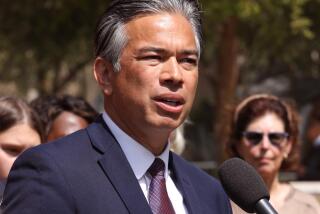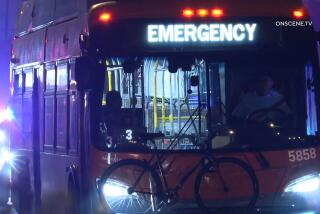Officials Call for More Details on MTA Plan
- Share via
Concerned about a Metropolitan Transportation Authority plan to decentralize its bus operations, several state senators Friday called for more details about what the changes would mean to Los Angeles residents.
“We want to make sure it improves bus service for the residents throughout Los Angeles,” said Sen. Richard Alarcon (D-Sylmar) at a public hearing in San Fernando on the agency’s plan to reorganize into five regional sectors.
Alarcon, chairman of the Senate Select Committee on the MTA and vice chairman of an audit committee, said a review by the state auditor’s office also would help “make sure the sector plan is implemented in a way that cuts costs and improves service.”
Sen. Gloria Romero (D-Los Angeles) said she was concerned that the sector plan, due to debut in the San Fernando Valley and the San Gabriel Valley July 1, would be more costly to taxpayers.
Sen. Richard Polanco (D-Los Angeles) said more information was needed on how the MTA intends to divide its resources among the regions.
Transit authorities said they did not expect the call for an audit but did not object.
“An audit might identify where we can make improvements,” said John Catoe, the MTA’s deputy chief executive. “It would be a win for citizens and a win for the agency.”
The MTA’s sector plan is intended to make the massive agency more efficient and responsive to the needs of bus riders, officials say. Already, the MTA has hired five general managers to take charge of each sector and is moving more than 100 employees from downtown to the regions.
Introduced by MTA Chief Executive Roger Snoble in December, the sector proposal would give each region more control over bus scheduling and routes. It came as separate groups in the San Fernando and San Gabriel valleys were completing plans to break from the MTA and form independent transit zones, an idea opposed by organized labor.
On Friday, union leaders told the senators and representatives for other state officials that they were skeptical of the sector plan.
“We feel the same or better efficiencies would be realized without sectors or zones,” said Neil Silver, president of Amalgamated Transit Union.
James Adams, president of Local 3634 of the American Federation of State, County and Municipal Employees, criticized the MTA for eliminating some supervisory jobs and having those employees apply for higher-paying but nonunion positions.
“If it’s not union-busting, it’s close to it,” Adams said.
Others who spoke at the hearing said they would like to see the sector plan lead to better service.
The new sectors should “be more inclusive for people with disabilities,” said Kurt Baldwin, an advocate for the Independent Living Center of Southern California in Van Nuys.
People who use wheelchairs, for instance, sometimes complain of bus drivers who do not stop to pick them up, Baldwin said.
Bart Reed, executive director of the Transit Coalition, a nonprofit advocacy organization, said bus riders “have major route gaps in the northeast San Fernando Valley.”
In the last few years, Reed added, “we keep going up in population but we keep losing services.”
Before the hearing, Alarcon held a news conference at which he said he is proposing legislation that, if the Valley secedes from Los Angeles, would place the mayor of an independent San Fernando Valley on the MTA board.
Alarcon has said he is considering running for mayor of an independent Valley.
More to Read
Sign up for Essential California
The most important California stories and recommendations in your inbox every morning.
You may occasionally receive promotional content from the Los Angeles Times.










